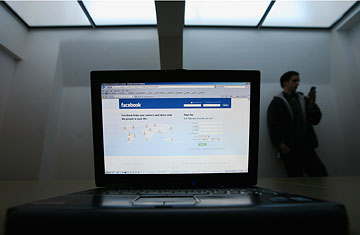
The social networking site Facebook displayed on a laptop screen on March 25, 2009 in London, England
(2 of 2)
TAP YOUR NETWORK TO STAY UPBEAT
Except it wasn't. Ward's skills and what the company needed didn't line up. Intellectually, he knew it was that simple, but the rejection stung, especially coming on the heels of having lost his job the week before. "You've just been told, We don't want you. That has a crushing effect on your soul," says Ward. "Then as you go out and look for a job, most of the jobs you look at you're not going to get. You're going to be told no over and over again."
Using social-networking sites to look for work — in addition to traditional job banks like Monster and Dice — helped with that emotional part of the job search. Twitter didn't provide many leads, but Ward did come across a lot of other people looking for work. "It turned into a big support network," he says. While he was looking for a job, Ward wasn't able to sleep more than a few hours a night. The first thing he'd do when he got up at 4 or 5 in the morning was send out a tweet. (See the best social-networking applications.)
GO BEYOND JOB-RELATED NETWORKING
LinkedIn proved more useful in finding possible positions. Early in his search, Ward watched a webinar by onetime arena football player Lewis Howes on how to better leverage LinkedIn. Sounds hit-or-miss but Ward got a lot out of it. He began joining LinkedIn groups, even those that weren't work-related, like one for members of his college fraternity. That landed him a note from a vice president at Cisco Systems — a man on the other side of the country who hadn't even gone to the same school as Ward was now telling him that he'd ask around to see who was hiring. Ward got a similar message from a recruiter in Texas; he didn't hire for technology jobs but would pass along Ward's résumé to the folks at his firm who did.
KEEP EVERYONE YOU KNOW IN THE LOOP
Over the course of the week, Ward kept a list of jobs he was working on: about 16 made it to the point of having a conversation with the person who was hiring, but then no further. As things changed each day, over the 12 to 15 hours he was devoted to job-hunting daily he sent out updates via Twitter, Facebook and Gmail to let all of his friends and contacts know who had been helpful. "It was the equivalent of sending a thank-you letter after an interview," says Ward.
DON'T COUNT ANYONE OUT AS USEFUL
The job Ward eventually landed came from an unexpected direction. A former co-worker sent him a teasing note through Facebook saying she was offended he hadn't asked her for a job. He hadn't even though of it: when they had last worked together, she was fairly junior. He'd missed the part of the story where she'd gotten her MBA and was promoted twice. She passed along his résumé and within days he was having an interview. In the meeting he was up-front: he said he needed to find a new job quickly and was interviewing at other companies, too. The next day, he had an offer. "It's still all about connections," says Ward. "What's changed is how you do it."
